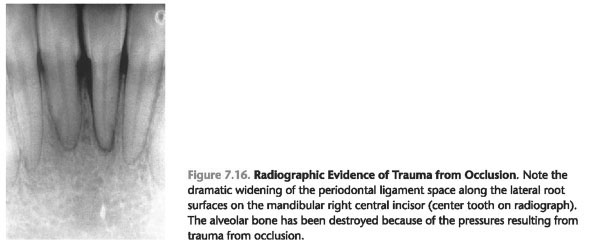Direct Damage from Occlusal Forces
A. injury from occlusion
1. Direct damage periodontal can result from excessive occlusive (or biting) forces on the teeth.
2. When excessive occlusive forces to damage the tissues of parodentium, this is called trauma from the bite.
* in cases where the injury from the bite occurs, some bone resorption of the alveolar may simply because of the increased pressure on the surrounding of the alveolar bone.
B. If you have a loss of some of the alveolar bone because of pressure because of injury from the bite, there may be more rapid destruction of any applicable periodontitis.
3. A thorough clinical examination and a thorough radiographic exam can often detect signs of injury from the bite.
a. Some clinical signs of injury from the bite that have been reported include the following :
1) the mobility of teeth
2) the pressure sensitivity
3) migration teeth
B. Some radiographic signs of injury from the occlusion this was reported include the following:
1) expanded in the form of a funnel periodontal ligament space
2) bone resorption of the alveolar ridge.
Fig. 7-16 shows an x-ray of the tooth, which was excessively occlusive forces (trauma from the bite).
4. Injuries from the occlusion was classified in the dental literature For many years, or major injury from occlusion or secondary trauma from the bite,
a. The primary trauma from occlusion is defined as excessive occlusive forces at the sound of parodont.
1) examples of reasons for the initial injury from occlusion include accidentally placing a high recovery or the introduction of a fixed bridge or a partial denture that creates excessive force on the base teeth.
2) changes in the main occlusal trauma to include a wider periodontal ligament space, tooth mobility, and even the teeth and jaw pain. These changes are reversible, if the injury is removed.

<img src="http://www.dent-wiki.com/img/ldent-95.jpg" alt="direct damage from Obstructive forces">
B. Secondary trauma of occlusion is defined as normal bite forces on unhealthy periodontal earlier due to periodontitis.
1) secondary trauma from the bite occurs tooth, in which surrounding periodontal experienced apical migration paroxizmalnaya form epithelium, loss of connective tissue attachment and loss of alveolar bone. In this type of trauma, periodontal, was unhealthy to excessive occlusive forces. Table 7-2 lists the definitions of some terms used to describe the injuries from the bite.
2) the tooth with unhealthy, inflamed tissues of parodentium, which is unduly occlusive forces, it is considered to be subject to more rapid loss of bone pocket and education.
3) teeth can be flipped sides easily when exposed side occlusive forces. These tips forces often accompany injury from occlusion and can create areas of pressure and tension in PDL transmitted bones. Fig. 7-17 shows how this turning point may occur. As bone loss alveolar progresses, this side tipping is even more likely, because the longer the lever created part of the tooth of the bone in the part of the tooth, encased in bone.
4) teeth with limited alveolar bone support may have additional damage of fabrics of parodont, because overturning the effect of lateral forces, placed on the teeth. Fig. 7-18 shows a series of drawings that illustrate this concept.
..
